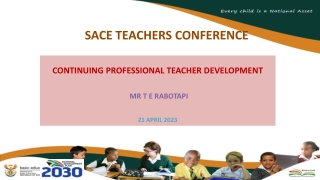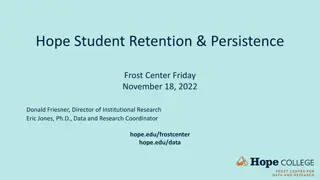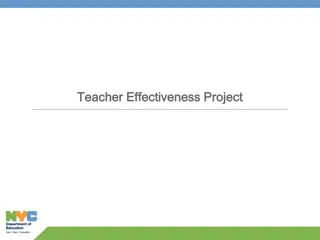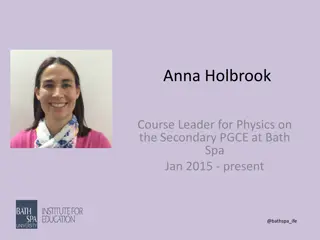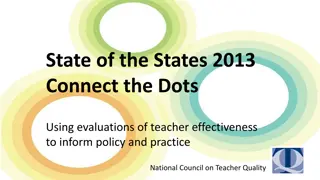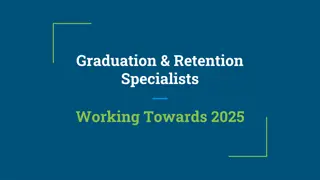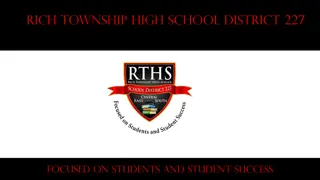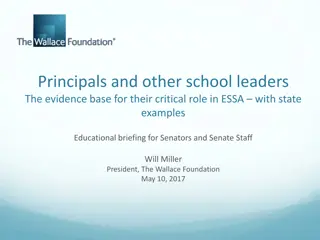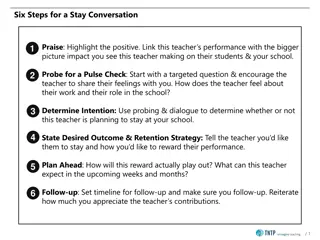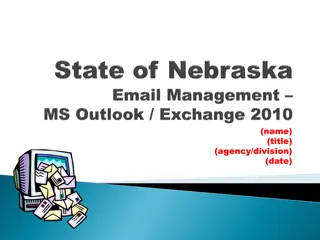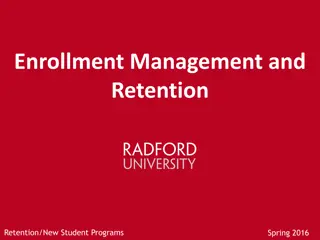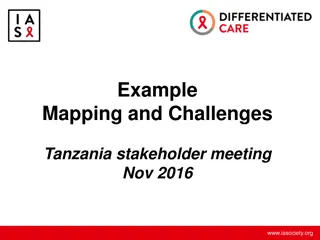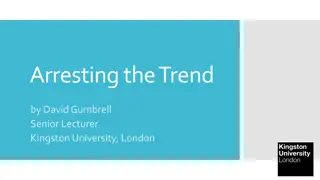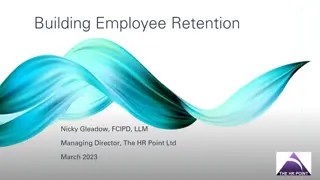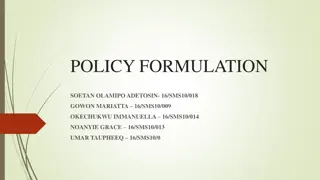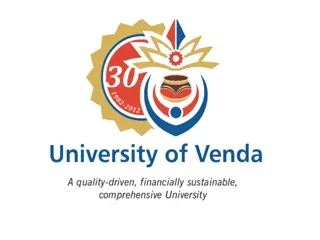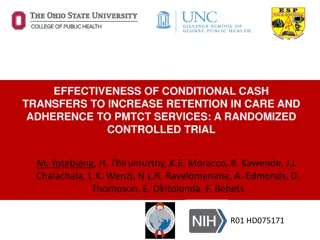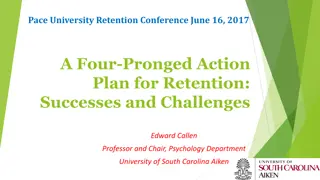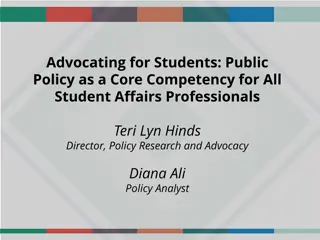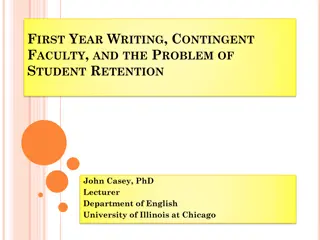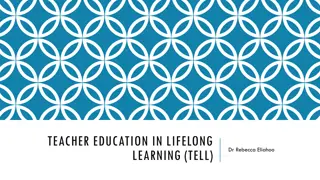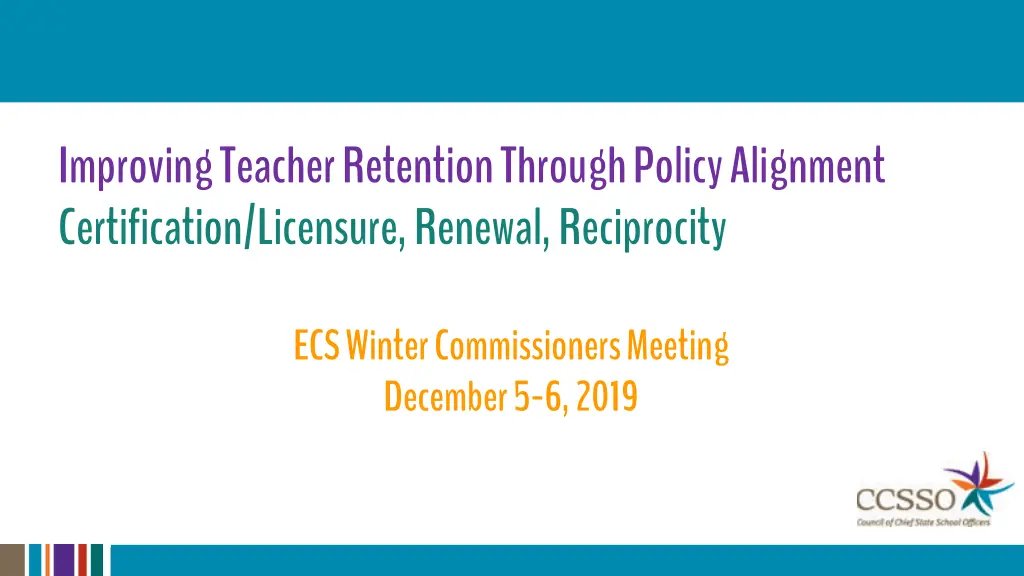
Improving Teacher Retention Through Policy Alignment Certification
Addressing teacher shortages and specific subject-based deficits through policy alignment, certification, and licensure systems to improve instructional quality, school climate, and student outcomes.
Download Presentation

Please find below an Image/Link to download the presentation.
The content on the website is provided AS IS for your information and personal use only. It may not be sold, licensed, or shared on other websites without obtaining consent from the author. If you encounter any issues during the download, it is possible that the publisher has removed the file from their server.
You are allowed to download the files provided on this website for personal or commercial use, subject to the condition that they are used lawfully. All files are the property of their respective owners.
The content on the website is provided AS IS for your information and personal use only. It may not be sold, licensed, or shared on other websites without obtaining consent from the author.
E N D
Presentation Transcript
Improving Teacher Retention Through Policy Alignment Certification/Licensure, Renewal, Reciprocity ECS Winter Commissioners Meeting December 5-6, 2019
Teacher Shortages Overview National Challenge, State-Specific Variations
Instructional quality is the most important in- school factor impacting student academic achievement and success.
Districts and schools across the country are facing severe shortages of teachers, especially in certain subjects and in specific schools.
Specific Shortages Subject-based Special education, mathematics, foreign language and ESL District- and/or school-based Often confined to specific geographic areas (urban, rural). Often confined to schools with specific characteristics (low-income, under-performing, high % students of color). Shortage of teachers who reflect the racial and ethnic backgrounds of their students.
Impact of Specific Shortages 1 2 3 Negatively impact workforce quality, school climate and student outcomes. Disproportionately impact the schools and students that can afford it the least. Costly.
Causes of Specific Shortages States are facing ongoing recruitment and retention challenges. Teacher shortages are impacted by the unique circumstances within each state and the unique education policies that govern that state. Teacher shortages are impacted by a chronic and perpetual misalignment of supply and demand.
Teaching in 2019 We expect more of teachers than we ever have before. Knowledge and Skills Socio-Emotional Learning and Growth We don t treat teachers as professionals. They are not generally recognized, valued, and rewarded as are other professionals. There is little opportunity for growth and advancement, from inside the classroom. Teachers don t have meaningful influence over the policies and practices that influence them and their kids.
Potential Solutions Certification and Licensure Systems
Why Certification and Licensure? Initial state licensure for educators like state licensure for most other professions regulates entry into the profession, and serves to provide the public with an assurance that every teacher is ethical, qualified, and competent. States also set policies for the renewal, or maintenance, of the teaching license which typically entail requiring educators to show proof of engaging in continuing professional learning to retain their license. More than half of states also encourage teachers to go above their minimum professional development requirements by offering an advanced license that provides additional status, compensation and/or responsibility. Recently, a few states have attempted to use teacher licensure renewal and advancement systems to encourage meaningful ongoing professional learning and growth.
Principles for Licensure Licensure should be a rigorous, yet clear, standards-based process to support 21st century teaching aligned to college-and career-readiness for all students. States should find consensus on expectations for licensed teachers to enhance efficiency and to ensure consistent teacher quality throughout the nation. Licensure renewal within states should support personalized growth for each teacher and align to coherent performance and learning expectations for teachers throughout their careers. Licensure systems should create meaningful opportunities for teacher career advancement.
Key Questions Licensure How can we promote a high bar to entry, while also avoiding exacerbating specific shortage areas? Renewal How can we ensure that recertification contributes to professional advancement as part of a coherent professional learning system, rather than a disjointed process or paperwork exercise? Reciprocity How can we better facilitate teacher mobility to make it easier for great teachers to move across state lines and especially to teach where they are needed most?
Reciprocity Certification and Licensure Systems
Teacher Licensure Reciprocity allows out-of-state teachers to earn a license in a receiving state subject to meeting the receiving state s requirements.
Full Licensure Reciprocity (2017) ME WA V T NH MA MT ND MN NY OR R I I D W I M I SD CT MD NJ WY PA DE I A OH NE I N I L WV Washington D.C. NV VA U T CA CO KY K S MO NC T N SC OK AR AZ NM GA AL MS T X LA F L AK H I Source: Teacher License Reciprocity (ECS, 2017)
Additional Assessments (2017) ME WA V T NH MA MT ND MN NY OR R I I D W I M I SD CT MD NJ WY PA DE I A OH NE I N I L WV Washington D.C. NV VA U T CA CO KY K S MO NC T N SC OK AR AZ NM GA AL Yes, for some or all candidates and not always immediately MS T X LA F L AK H I Source: Teacher License Reciprocity (ECS, 2017)
Additional Coursework (2017) ME WA V T NH MA MT ND MN NY OR R I I D W I M I SD CT MD NJ WY PA DE I A OH NE I N I L WV Washington D.C. NV VA U T CA CO KY K S MO NC T N SC OK AR AZ NM GA Yes, for some or all candidates and not always immediately AL MS T X LA F L AK H I Source: Teacher License Reciprocity (ECS, 2017)
State Example: Maine To obtain a standard license: Three years of successful teaching experience. Praxis II content assessment (basic skills and pedagogy assessments are waived if in the same endorsement area). Additional coursework (or substitute CLEP assessment) if deficiencies are found on transcript evaluation.
State Example: Pennsylvania To obtain a standard license: Two years of satisfactory experience. Approved content test (and basic skills test if less than two years experience). Additional coursework if deficiencies in preparation and experience are found.
What does the research say? Teachers are far less likely to move across state lines than within state lines. State-specific licensing requirements limit interstate teacher mobility. State-specific licensing requirements may exacerbate shortages.
What does the research say? Barriers to mobility include: Unclear reciprocity laws State-specific licensing structures (e.g. tiers, content areas and grade spans) Fees Duplicative or new coursework and/or exams Seniority-based policies and pay structures Tenure Pension plans
What does the research say? Reducing barriers/improving interstate mobility might support: teacher recruitment. job satisfaction. reduced attrition in the profession. reduced barriers for mobile populations, including military spouses.
Enacted Legislation 2018-2019 ME WA V T NH MA MT ND MN NY OR R I I D W I M I SD CT MD NJ WY PA DE I A OH NE I N I L WV Washington D.C. NV VA U T CA CO KY K S MO NC T N SC OK AR AZ NM GA AL MS T X LA F L AK H I
Common Elements of Legislation Providing special reciprocity/supports to military spouses (at least 8 states). Removing coursework/assessment/evidence of effectiveness requirements (at least 7 states).
Limiting barriers to reciprocity could support the more fluid movement of teachers from areas where they are not needed, to areas where they are.
Interested in learning more? Teacher Recruitment and Retention (2019) Targeted Teacher Recruitment (2018) Teacher License Reciprocity (2017) Teacher Shortages: What We Know (2016)

